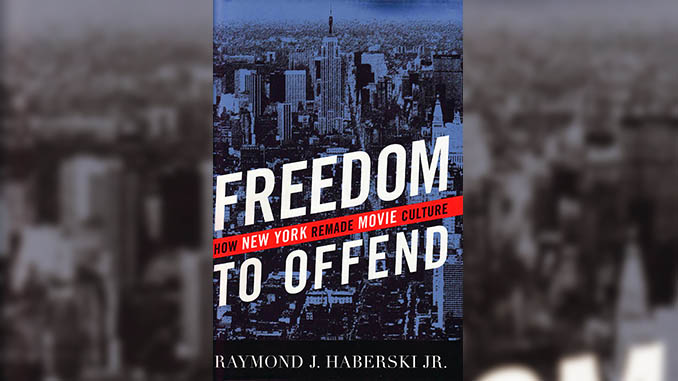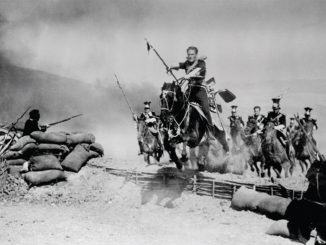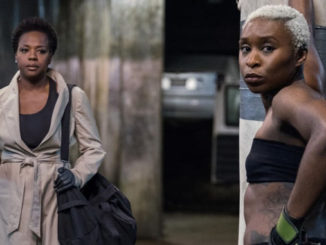
by Ray Zone
Freedom to Offend
How New York Remade Movie Culture
By Raymond J. Haberski, Jr.
University Press of Kentucky
266 pps, hardbound, $45.00
ISBN: 978-0-8131-2429-2
Raymond J. Haberski, Jr. is a student of movie culture, recording the history of film criticism itself, its effect upon motion picture production and the movie viewing habits of the public. In his previous book, It’s Only a Movie: Films and Critics in American Culture (University Press of Kentucky: 2001), Haberski traced the rise and fall of movies as art and the role of the critic in the process. With his new book, Haberski has dialed in on a specific time and place to show how New York in the years after World War II became the site of a conversation “over the expectations and concerns of a post-censor movie culture. That conversation has had consequences for our own time because it remade the idea of confrontational cinema into a kind of intellectual style.”
From the earliest days of American cinema, New York was the largest market for every kind of film and the center of what Haberski characterizes as a “web of control” with the most influential state censorship board in the United States, the New York State Motion Picture Division. Millions of Catholics also lived in New York, which extended the influence of the Legion of Decency, an organization within the Catholic Church that reviewed films and threatened those it “condemned” with public boycott. The Production Code Administration (PCA) of Hollywood had a New York office and cooperated closely with the Legion of Decency.
Another staunch advocate of censorship was Martin Quigley, a Catholic and publisher of the trade journal Motion Picture Herald, who was instrumental in the formation of the PCA in the 1930s and was still active into the 1960s. Several cultural critics, including Brooks Atkinson and Bosley Crowther of The New York Times, were opposed to the chilling effects any form of prior censorship had on filmmaking.
Among the critics writing in New York as “the crucible of a new popular aesthetic,” Haberski notes the influence of Susan Sontag. With a series of radical essays collected in her 1966 book Against Interpretation, Sontag “argued that American culture needed a way to transcend the ideal of linking culture to society’s moral health.” She declared that a “‘new sensibility’ had emerged that rejected the evaluation of art based on content and social purpose.”
New York was the center of what Haberski characterizes as a “web of control” with the most influential state censorship board in the United States.
To begin his survey of this critical shift, Haberski returns to 1949 with the release of the Italian neo-realist film The Bicycle Thief in Manhattan, which “revealed what was wrong and what was right with movie culture.” Distributed by an independent New York distributor, Joseph Burstyn, without the PCA seal of approval in New York, The Bicycle Thief garnered much critical praise for its realistic treatment of life. Burstyn had released other neo-realist Italian films, such as Paisan and Open City, and had honed his marketing skills to a commercial art. Distributing his films in small art theaters in New York, Burstyn achieved modest commercial success and exceptional critical notice. The Bicycle Thief won Best Foreign Film of the Year from the New York Film Critics Circle, as well as the National Board of Review’s top prize as the Best Film of the Year. In addition, the film had already been licensed for exhibition by the New York State Board of Censorship. With The Bicycle Thief, Burstyn had a shot at wide national distribution.
The success of The Bicycle Thief had attracted the attention of Warner Bros. and, at the request of Jack Warner, Burstyn sent a print of the film to the PCA in Hollywood where it was screened on January 31, 1950 for Joseph Breen, head of the PCA. Breen demanded the excision of two scenes––one that showed the young protagonist relieving himself against a wall and another that showed a brief but innocent look inside a brothel. Burstyn and director Vittorio de Sica refused to make any cuts to the finished film. Exploiting the controversy, Burstyn ran ads in New York City newspapers highlighting PCA efforts to “cut” The Bicycle Thief.
“Burstyn and de Sica had run up against a sensibility that had shaped American movie culture almost since the inception of filmmaking,” writes Haberski. “Breen’s response to The Bicycle Thief was not only consistent with that sensibility, it was part of a system of obstructions—a web of control—designed to preserve the nation’s movie culture as a clean, traditional and mostly American entertainment. De Sica’s film grated against such principles by being realistic, modern and foreign.”
Haberski’s fascinating history of the film culture wars covers a series of controversies from the 1950s and ‘60s up to the early ‘70s with the release of Deep Throat, when pornographic films acquired legal “free speech” protection under the First Amendment. Along the way, capsule histories of Amos Vogel’s Cinema 16 film society, Jonas Mekas, Andy Warhol’s Chelsea Girls, Bonnie and Clyde (and its effect upon Bosley Crowther’s career) and the genesis of “porno chic” are entertainingly presented.
Haberski thoughtfully concludes, “It became intellectually chic to think of pornography as an art form in need of a defense.” For the rest of the story, readers may want to consult Jon Lewis’s fine history Hollywood v. Hard Core: How the Struggle over Censorship Saved the Modern Film Industry (New York University Press: 2000), which details the creation of the industry-wide MPAA (Motion Picture Association of America) film rating system, Hollywood’s response to porno chic, and its effective re-establishment of the “web of control” which had been diminished by the early 1970s.





